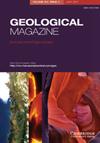New Cretaceous crickets of the subfamilies Nemobiinae and Podoscirtinae (Orthoptera, Grylloidea: Trigonidiidae, Oecanthidae) attest the antiquity of these clades
IF 2
3区 地球科学
Q3 GEOSCIENCES, MULTIDISCIPLINARY
引用次数: 0
Abstract
Abstract Fossils are more and more used in phylogenetic evolutionary studies either for clade calibration, or as terminals in a dataset including morphological characters. The strength of these methodological advances relies however on the quality and completeness of the fossil record. For crickets (Insecta, Orthoptera, Gryllidea), few ancient (pre-Cenozoic) well-preserved fossils are known, except for isolated wings often classified in purely fossil groups and a few fossils found in Cretaceous amber. Here, we present two remarkable fossils from mid-Cretaceous amber of France, that were imaged using X-ray synchrotron microtomography and exhibit an exquisite preservation allowing description with a precision similar to that of extant taxa. Palaeonemobius occidentalis Laurent and Desutter-Grandcolas, gen. nov., sp. nov. and Picogryllus carentonensis Josse and Desutter-Grandcolas, gen. nov., sp. nov. are the oldest representatives of the Nemobiinae and Podoscirtinae subfamilies of the Trigonidiidae and Oecanthidae families respectively. P. carentonensis Josse and Desutter-Grandcolas, gen. nov., sp. nov. is also the smallest adult male with a full stridulatory apparatus ever documented in crickets (body length 3.3 mm), and the first taxon of the cricket clade for which male genitalia can be partly described. We discuss the significance of Cretaceous fossils of crickets for future evolutionary studies of this clade.Nemobiinae和Podocurtinae亚科的白垩纪新蟋蟀(直翅目,蟋蟀总科:三角蟋蟀科,蟋蟀科)证明了这些分支的古老性
摘要化石越来越多地用于系统发育进化研究,要么用于分支校准,要么作为包括形态特征的数据集中的终端。然而,这些方法学进步的力量取决于化石记录的质量和完整性。蟋蟀(昆虫纲、直翅目、蟋蟀总科),除了通常被归类为纯化石组的孤立翅膀和白垩纪琥珀中发现的一些化石外,几乎没有已知的古代(新生代前)保存完好的化石。在这里,我们展示了两个来自法国白垩纪中期琥珀的引人注目的化石,它们是使用X射线同步加速器显微成像技术拍摄的,保存完好,可以以与现存分类群相似的精度进行描述。Palaeonamobius occidentalis Laurent和Desutter Grandcolas,gen.nov.,sp.nov.和Picogryllus carentonensis Josse和Desutter-Grandcolas(gen.nov..,sp.nov)分别是三角藻科和Oecanthidae科的线虫亚科和足目昆虫亚科的最古老代表。P.carentonensis Josse和Desutter Grandcolas,gen.nov.,sp.nov.也是蟋蟀中有记录以来体型最小的成年雄性(体长3.3毫米),也是蟋蟀分支中第一个可以部分描述雄性生殖器的分类单元。我们讨论了蟋蟀白垩纪化石对该分支未来进化研究的意义。
本文章由计算机程序翻译,如有差异,请以英文原文为准。
求助全文
约1分钟内获得全文
求助全文
来源期刊

Geological Magazine
地学-地球科学综合
CiteScore
4.70
自引率
0.00%
发文量
111
审稿时长
3 months
期刊介绍:
Geological Magazine, established in 1864, is one of the oldest and best-known periodicals in earth sciences. It publishes original scientific papers covering the complete spectrum of geological topics, with high quality illustrations. Its worldwide circulation and high production values, combined with Rapid Communications and Book Review sections keep the journal at the forefront of the field.
This journal is included in the Cambridge Journals open access initiative, Cambridge Open Option.
 求助内容:
求助内容: 应助结果提醒方式:
应助结果提醒方式:


